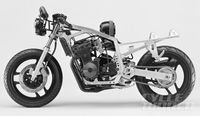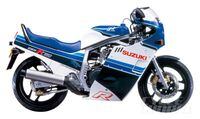If you haven’t seen our video on the history of the Suzuki GSX-R yet, do so now. Called “Suzuki GSX-R: 30 Years of Performance,” it celebrates the 30-year history of the legendary bike via a visit to Suzuki Headquarters in Hamamatsu, Japan, where we spoke with the original engineers, a bunch of guys who loved racing. For fun, we sent the video to another guy who loves racing, Technical Editor Kevin Cameron, and asked for his thoughts. Here’s Kevin’s reply:
What I particularly remember from that time was weight growth. Someone had to break out of the 1970s thinking that just kept making things out of steel. Suzuki did so with the GSX-R, Honda with the 1986 V4. This, combined with hard work to reduce engine weight, resulted in four-strokes that less deserved to be called "Diesels," the name given them by the GP paddock.
Recall that the 1025cc sit-up Superbikes (1976-1982) had engines that weighed 225 lb., frames that needed approximately 30 lb. of tube and plate added to achieve even a modicum of straight-line stability, and front wheels that alone weighed 50 lb. Those bikes turned their brake discs into blackened tacos. They wiggled and they weaved. They rattled out their cranks. The unreliability of their engines was such that AMA dared not stage races for them over 50 miles.
One Wednesday morning at Daytona, as I walked through the paddock, in front of the Suzuki and Kawasaki garages, I counted five wrecked sets of cases from Monday and Tuesday at one, and three at the other. Those were really dreadful race bikes, completely unsuited to competition and needing everything to be gussied-up.
It was in response to this ghastly record of chronic failure of 1970s concepts that the makers reviewed what they were doing and took a completely new direction. That was the real origin of modern sportbikes and our expectations of them.



/cloudfront-us-east-1.images.arcpublishing.com/octane/3ZKIVLW4BBHV7FSYYODYL55OIQ.jpg)
/cloudfront-us-east-1.images.arcpublishing.com/octane/BW43XOMS5RA2RB5QLEXD4NTNYE.jpg)
/cloudfront-us-east-1.images.arcpublishing.com/octane/GMG6KKHK4ZDLBFILW6L5UHJC4M.jpg)
/cloudfront-us-east-1.images.arcpublishing.com/octane/6BQBLTD22JHEFH2OBE5ZGY74NU.jpg)
/cloudfront-us-east-1.images.arcpublishing.com/octane/OVNMRSCISBB2FG4GQLQAYN56MU.JPG)
/cloudfront-us-east-1.images.arcpublishing.com/octane/7KSW4EGJWBGKFA62G4OARG7POU.jpg)
/cloudfront-us-east-1.images.arcpublishing.com/octane/OX5X6DCDXRBHBDLSLR2PRRJMSE.jpg)
/cloudfront-us-east-1.images.arcpublishing.com/octane/4FN63Z3XEVBMBDP3W6GFPLICRU.jpg)
/cloudfront-us-east-1.images.arcpublishing.com/octane/2CYHINRF5RA7VBO3PRJPVU5IBE.jpg)
/cloudfront-us-east-1.images.arcpublishing.com/octane/X7JX7MGA5ZBCDGDVAA2LKUGCTQ.jpg)
/cloudfront-us-east-1.images.arcpublishing.com/octane/7TO4TMPM6JBJJPBWUMT35TJHHA.jpg)
/cloudfront-us-east-1.images.arcpublishing.com/octane/3CANJMY47BH6BNPDAODAUD3CWQ.jpg)
/cloudfront-us-east-1.images.arcpublishing.com/octane/4IGJJZ6HWNAIHJ343U7CUH4WC4.jpg)
/cloudfront-us-east-1.images.arcpublishing.com/octane/BP5NOY5NPVGOZIDU5FN7M42JMA.jpg)
/cloudfront-us-east-1.images.arcpublishing.com/octane/XH2ETEU4NVGDFNQO2XT2QQS5LU.jpg)
/cloudfront-us-east-1.images.arcpublishing.com/octane/TGJNNI474VFXFMS3YQDRIEKEFY.jpg)
/cloudfront-us-east-1.images.arcpublishing.com/octane/5QAQVX645VA3LKJFZ3C4Y2DTPI.jpg)
/cloudfront-us-east-1.images.arcpublishing.com/octane/45O2MZU525ATPB5GRG422ZTU54.jpg)
/cloudfront-us-east-1.images.arcpublishing.com/octane/WEWXDN2F2BD3DJYUJJX4RZIALA.jpg)
/cloudfront-us-east-1.images.arcpublishing.com/octane/VPDWRXQWRVGULBY7Z3JRGPTR2I.jpg)
/cloudfront-us-east-1.images.arcpublishing.com/octane/56QNDMMUA5EA3OCJINPCI2QZGA.jpg)
/cloudfront-us-east-1.images.arcpublishing.com/octane/BHOJALDF55CPXGFWVLVKBPYZZI.jpg)
/cloudfront-us-east-1.images.arcpublishing.com/octane/BRQMHRCC4FH5HK4D3HUMG6XEKM.jpg)